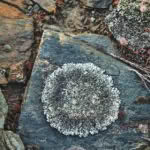An architectural wonder in an unlikely paradise
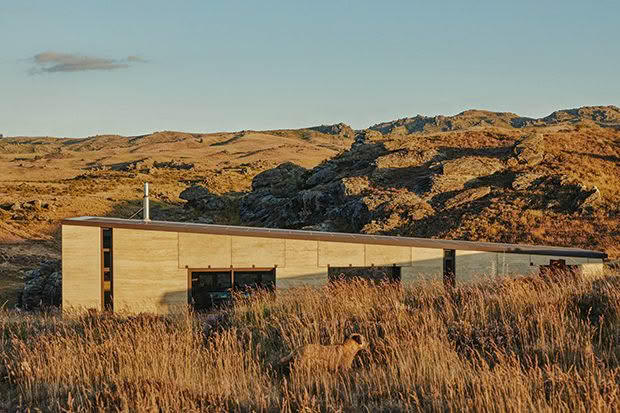
“We didn’t want a great big edifice up on the hill, and we wanted to build something beautiful as cheaply as possible,” say the owners of this home in thyme on Raggedy Ridge in Central Otago.
A house made of rammed earth, described by its owners as an “above- ground rabbit burrow”, suits one of the country’s most extreme climates and allows its inhabitants to connect to the elements should they choose.
Words: Kate Coughlan Photos: Brent Darby
It was more than love at first sight when Ronnie Alkema and Gary Stewart scrambled up a shingle track barely the width of a car and, stepping over thyme bushes, reached an outcrop of schist tors and lifted their eyes to the northwest. The Wellingtonians (he a graphic designer and she a garden designer) were hunting for land to stretch their artistic souls. Queenstown had initially drawn their attention, but it was too expensive, too busy, and they couldn’t feel any magic; Lowburn, Cromwell, Bannockburn, Clyde, Alexandra, Conroys Dam, Galloway … the search for something special took them ever more east into the drier, rockier, more extreme landscapes of the ancient glacial valleys of Manuherikia, Ida and Maniototo and into the heartland of Central Otago.
After another unsuccessful day with a real estate agent, they remembered the photogenic village of Ophir they’d once briefly visited on a motorbike tour with mates. They swung off the main road at Omakau for a look-see to fill in time before returning to Clyde and their B&B. A beautiful stone building beckoned with an “Open” sign. Soon, a glass of pinot in hand, they were deep in conversation with Colleen Hurd, proprietor of the landmark Pitches Store. She listened to the saga of their hunt for property and told them of special land that might be for sale near the historic Daniel O’Connell suspension bridge south of the village. Colleen helpfully drew a map on a serviette as it was a tricky spot to locate. When they parked their car at a chain strung across the shingle track rising through land covered in wild thyme and briar, napkin map in hand, they wondered if they were in the right place.
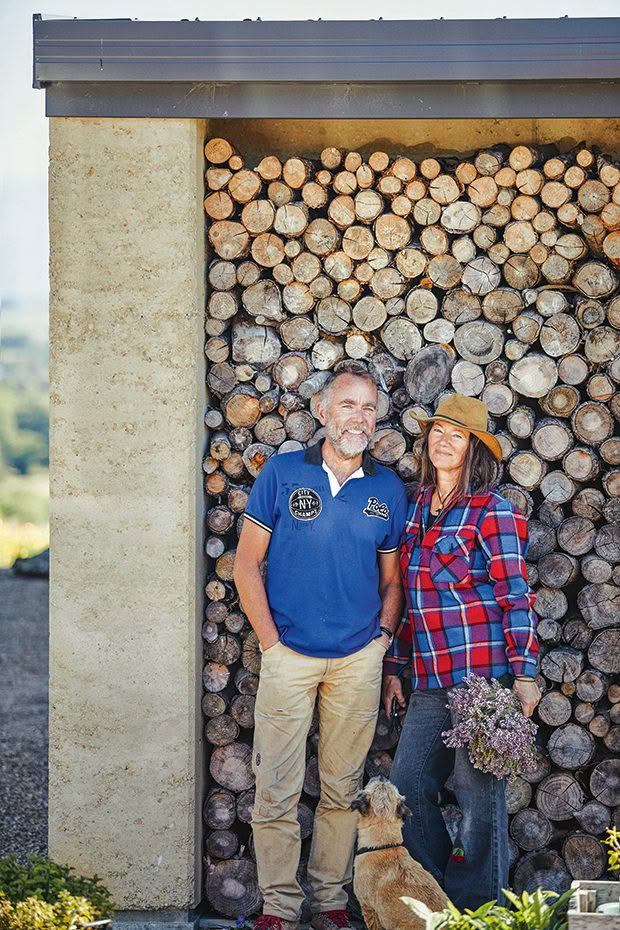
Soil for the house, owned by Gary Stewart and Ronnie Alkema, came from the Cardrona Valley and blended perfectly into the colour of the vegetation surrounding the home. Using soil from their site would have been expensive due to its requirement for a specific structural integrity, and excavation would have damaged the fragile landscape.
“Even before we turned and saw the view, my heart was beating so fast I could hardly breathe,” recalls Ronnie. She was overwhelmed, unable to speak; such was her excitement. Gary, too, was initially lost for words.
“I don’t know if this is the pinot talking,” he said after a few minutes, “but this is it.”
“Yes, this is it,” confirmed Ronnie. “And it had nothing to do with the wine,” she says over a decade later. “Our response was entirely visceral, no logical thought, just an emotional response.”
- “There’s beauty everywhere, and the more you look, the more you see,” says Ronnie. She’s fond of the tiny plants she finds on the land, especially lichen, which grows on the rocks and inspires the colours of their home décor.
They sat on a ledge of rock worn to a comfy seat by wind and rain, warmed by the day’s sun and decorated in doily patterns of yellow and white lichen. They looked across the dry plains to the massive mauve shoulders of the Dunstan Range in the north. They breathed in the powerful aroma of wild thyme and listened to the hawks wheeling in the updraughts of the endlessly blue sky.
They’d come home. It was exactly, perfectly, everything they’d imagined — and hoped — they could find. When they could tear themselves away from the mesmerising view, and with barely contained excitement, they rushed to see Colleen and contact the owner. That was in late May 2012.
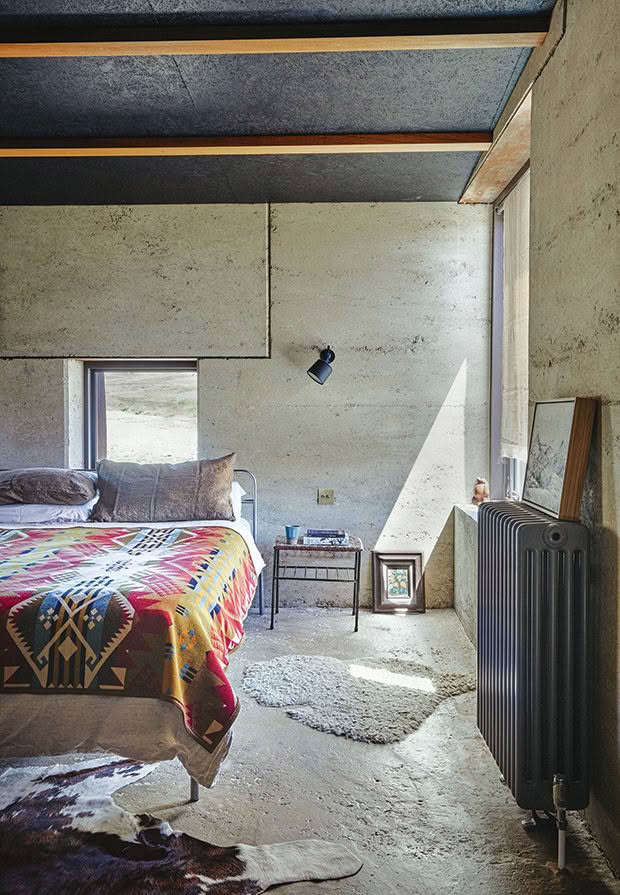
The bedroom and bathroom at the south end of the house are separated from the main living area by the breezeway, creating a hunkered-down, protective feeling during wild weather. “We enjoy crossing from one part of the house to the other through the breezeway,” says Ronnie. “It means we have kept the feeling of camping — the interaction with the weather makes the protection and comfort of the interior spaces feel all the more tangible.”
They planned to camp on the land each season and build a permanent home in 10 years or so. With each visit, it became harder and harder to leave, and a little more of their hearts stayed behind when they departed.
Initially, they camped in a tent until a particularly brutal visit from the Matakanui Express (the local nickname for the prevailing wind) tore out their tent pegs and snapped the poles at ground level. It was a scary night, even with the tent eventually tied to their Land Rover to avoid it becoming airborne — them included.
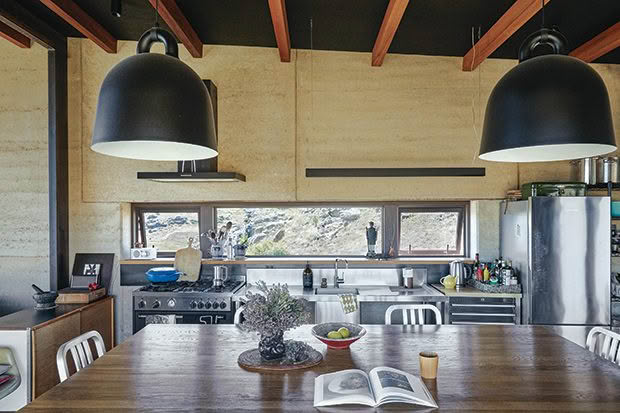
They purchased an Airstream caravan — a vintage 1970s model with original moss-green polyester shag-pile carpet. It was life-changing; its underfloor voluptuous water tanks provided a ballast against even big blows. Parked nose into the wind, it lives up to its name as fierce gusts stream by. The Matakanui Express has clocked speeds at nearly 200 kilometres an hour. Even in a storm that lifted roofs and blew down sheds in Matakanui and Ophir, the Airstream didn’t move an inch.
With interior refurbishment providing stylish comfort, a mobile phone tower erected nearby enabling excellent communications (at last) and the departures ever more wrenching, they shortened the 10-year plan to a seven-year one. Christchurch-based architect Charlie Nott was brought in to begin designing their house. This visually strong pair had compiled a significant Pinterest collection of their architectural likes, and the building began in 2019.
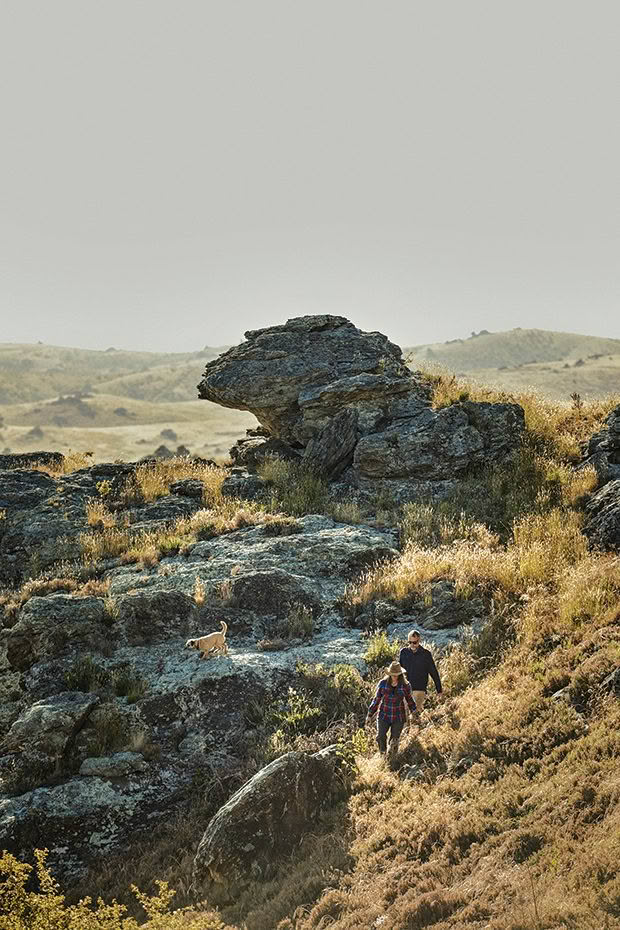
Ronnie and Gary call the dramatic schist outcrop, visible from many areas on the plains, Big Man Star Gazing. A garden designer, Ronnie likes the harsh landscape for its monumental and raw feeling. “It gives me a feeling of space and reminds me of the Scottish Highlands with big ranges and valleys.”
“We feel lucky that we didn’t do a quantity survey of the plans, as we’d never have built this house,” says Ronnie, noting it cost a third more than expected. “We would, perhaps, have had to build something more conventional. And we feel even luckier that we got it built before Covid-19 sent prices higher again, as we could never afford it now.”
They also feel grateful for the experience of living on the site for the valuable understanding of all its joys and drawbacks. “We wanted the house to be solid as a rock,” says Gary, “as it was a challenging site for a dwelling. We were also aware that it would be visible from the nearby towns of Omakau and Ophir, and we didn’t want it to stand out on the hill. We wanted a modest building, blending in with its surroundings.”

The bedroom and bathroom at the south end of the house are separated from the main living area by the breezeway, creating a hunkered-down, protective feeling during wild weather. “We enjoy crossing from one part of the house to the other through the breezeway,” says Ronnie. “It means we have kept the feeling of camping — the interaction with the weather makes the protection and comfort of the interior spaces feel all the more tangible.”
The resulting rammed earth structure is 90 per cent soil and 10 per cent dry cement (as required by the local council) and works well in temperatures that reach plus-30 degrees Celsius in summer and plummet to minus-12 degrees Celsius in winter. Ophir’s claim to temperature fame (or infamy) comes with the lowest recorded temperature in New Zealand; in the winter of July 1995, minus-21.6 degrees Celsius was recorded near Ophir village.
Ronnie loves the climate and is invigorated by the daily temperature range. “We can have a frost in the morning and mid-30s in the afternoon,” she says, noting, less enthusiastically, that a January frost this year took out her potato crop, along with others in the Ophir village. This was quite a blow as the annual Easter Spud Dig is one of the village’s most important fundraising events.
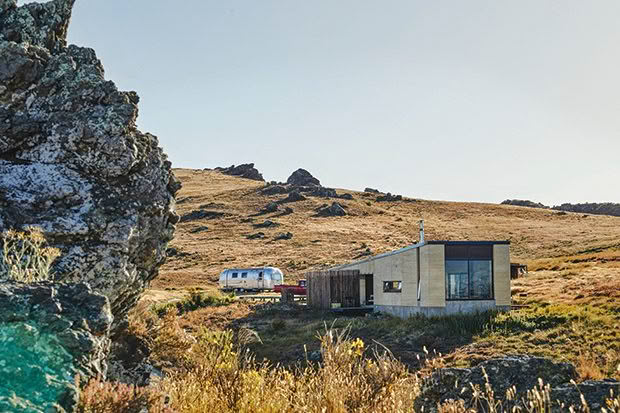
The Matakanui Express didn’t see them off, nor did the challenge of working remotely, especially once the mobile phone tower went in, guaranteeing an excellent internet connection. Gary already had clients spread throughout New Zealand. However, Ronnie wound down her Wellington-based business and took over managing their build.
Gary says they were early adopters of the remote working system that, post-Covid, is the norm. He was lucky that the gracious Colleen let him take up near-permanent residence at a corner table in Pitches Store, referred to as “Gary’s office”. He’d vacate his spot when the café started to get busy, allowing Colleen to cater to hungry clients. After all, there were only so many cheese scones and flat whites Gary could consume to contribute to his table rent. For a while, he took up work residence in the foyer of the Ophir Peace Memorial Hall, but as tourists thought he was a caretaker and expected guided tours, it wasn’t so good for workflow.
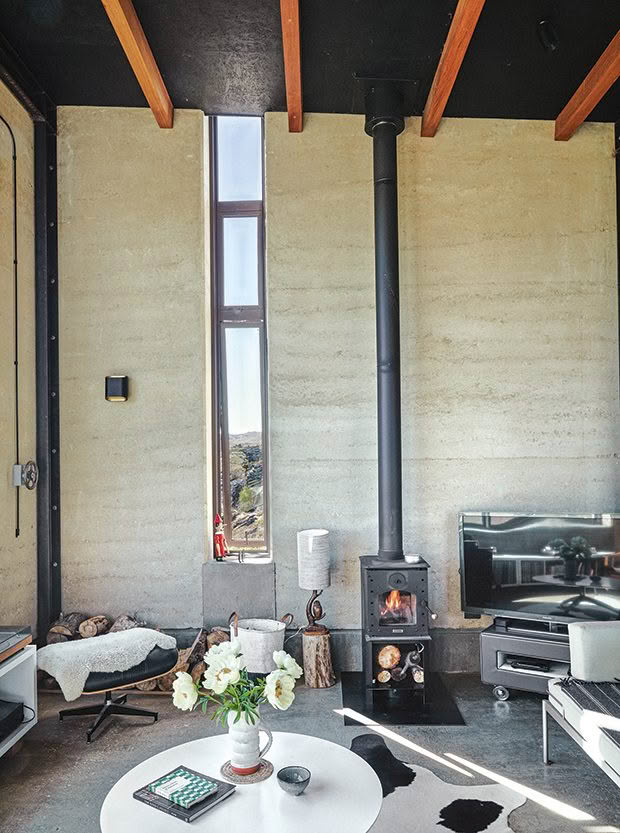
A Warmington ‘Studio’ wood burner keeps the house cosy in winter. The infrastructure for central heating is in place, with radiators and underfloor heating in the bathrooms plumbed in, but yet to be hooked up.
These days, with the house complete — for now at least — and winning awards, Ronnie is returning to her garden design and maintenance career. She’s learning about plants that flourish in this harsh environment, and her garden is an experimental zone. She’s trying out plants to suit the new “prairie/perennial” movement — with some success.
“You know, a gardener’s garden is not always the best tended,” she says. “When I get home from doing other gardens, I am not always enthusiastic about my own. It must survive my neglect. I learn a lot that way.”
What she’s discovered about their land is its susceptibility to disturbance. The frail, wind-blown loess (soil type) doesn’t cope with the compaction that inevitably accompanies the building process.
“There’s no regeneration of the original wild grasses and thyme that covered the site but wave after wave of weeds. We have to sit this out and let the ecosystem recover.”
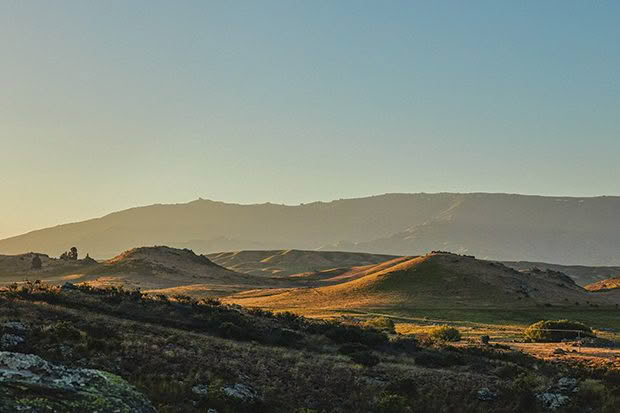
The Manuherikia River, in the gorge below, was the site of significant gold mining in the 19th century. Chinese miners worked the area, and their beautifully constructed stone-sided water races are still visible in some places, as are the remains of an old water dam and cookhouse.
Meanwhile, she has been working with a local design and build landscaping company and enjoying learning about what works in this region. “I’m doing a bit of hands-on planting, which keeps me physically busy. I like to do the planting work when I design a garden — it’s the icing on the cake.”
At some stage, and when budgets allow, there are refinements Ronnie and Gary wish for their home — adding sliding doors on either side of the breezeway to give the space its full potential for example. But in the meantime, every time they lift their eyes to the hills, they still feel the magic and are as much in love with the site as they were on that May day in 2012.
“I see beauty everywhere,” says Ronnie. “In the smallest thing that, at first glance, looks dead and brown, but look more closely at the lichen and mosses, and it is beautiful. I love the extremeness of it, the magnitude of it and the excitement of such a climate.”
HOW TO FIT INTO A TIGHTKNIT COMMUNITY
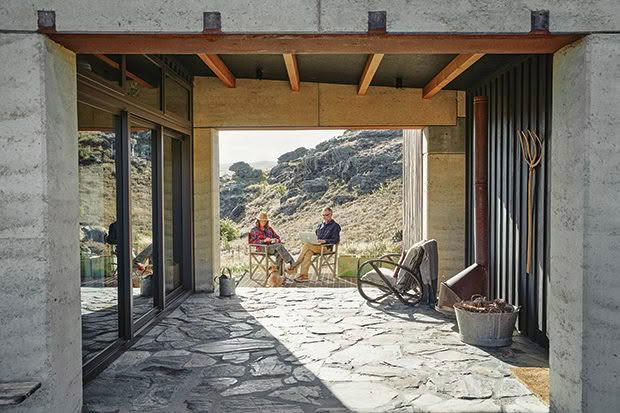
At some stage, the couple may build in the breezeway with sliding doors — one of a few future projects from Charlie Nott’s encampment plan they may complete as time and money allow. There’s no rush, however, as there’s always a reason to stop and smell the thyme.
In 2012, when Ronnie and Gary began visiting Ophir (a population of approximately 60 full-time residents), initially as “cribbies” (regular visitors), they wanted to establish a foothold in the local community.
They quickly learned that locals connected at the pub (Blacks) every Friday night. Now, as fully fledged community members, they partake in the Easter Spud auction — “the No.1 event of the social calendar in Ophir”, says Gary.
Every Labour Weekend, the Ophir Welfare Committee sells seed potatoes to residents and crib owners wishing to compete in the annual Easter Spud Auction — a fundraiser the committee has run for many decades.
On Easter Saturday, a committee member visits contestants to dig, weigh and count competition potatoes. The shaw is the yield of one potato plant and the heaviest on record in the competition is a whopping seven kilogrammes. Prizes are also awarded for the heaviest individual spud, the weirdest-shaped one, and even the lightest shaw, which one year was so light it didn’t register on the scales. Permanent residents and cribbies compete in separate categories. Everyone gathers on Easter Sunday for a potluck dinner and auction in the hall to buy back their spuds at hugely inflated prices to raise funds.
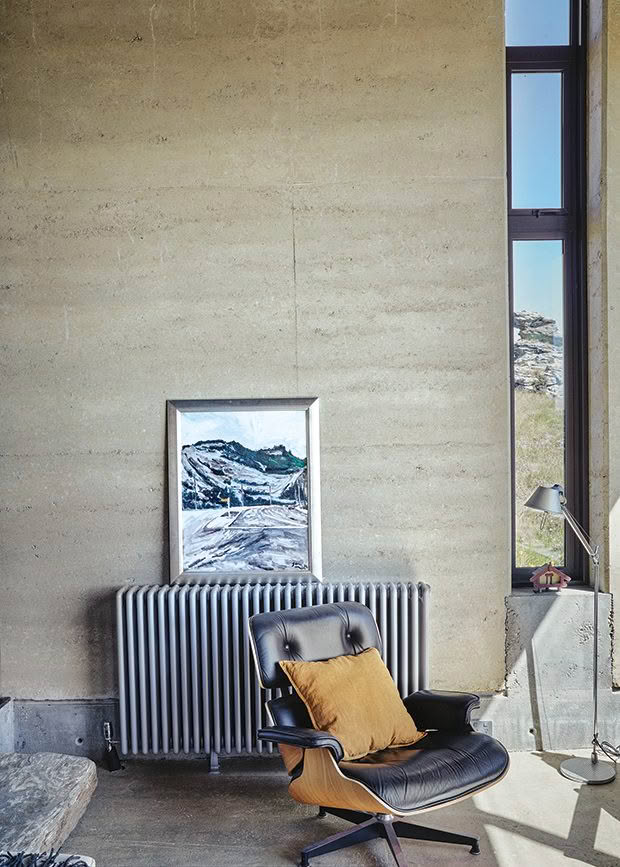
The home’s interior walls are raw, rammed earth, the same as the exterior. “We chose not to seal it to keep the soft, tactile texture,” says Ronnie. “The floor is also rammed earth with a protective coating of beeswax and linseed oil to make it hard-wearing and easy to clean”.
“We like being part of the village fabric,” says Gary. “If you want to get stuff done in a small community, don’t wait on the council to do it. We all pitch in when needed. Keeping the swimming pool open, for example. It is an important part of the community in summer, with rail-trail visitors, local kids and adults all using it to cool down. It is maintained on a volunteer roster and paid for via an honesty box.”
It’s the same with the Ophir Peace Memorial Hall, dating back to 1926. Gary is involved with a group of fundraisers who stage artist concerts in the hall, as it now has an excellent sound system.
“Our most recent artist was an Italian harpist, so it can be pretty random but always gorgeous,” he says. The visiting artists get a free night’s accommodation in the village, and everyone is happy.
AWARDS GALORE

• 2023 NZIA Southern Region Architecture Award — Housing
• Architecture Now Interior Awards 2023 — Residential
• 2023 Best Design Awards — Gold
While Gary and Ronnie are proud their home has won so many awards, Gary says (tongue firmly in cheek) that they are a pain in the arse. “I think Charlie entered the house into everything that was going. Do you know how long it takes to clean our windows? Two lots of judges’ visits, four separate shoots for books and magazine articles and the furniture craftsmen Woodwrights from Christchurch shot their catalogue and marketing material here … that’s a lot of weekend time taken up with tidying and cleaning.”
 This article first appeared in NZ Life & Leisure Magazine.
This article first appeared in NZ Life & Leisure Magazine.
